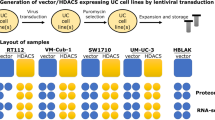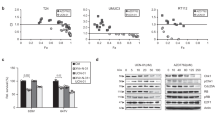Abstract
Studies on bladder cancer cell lines have shown that low adenoviral (Ad) infectivity is associated with low-level coxsackie adenovirus receptor (CAR) expression. Recently, we and others demonstrated a tumor stage- and grade-dependent downregulation of CAR expression in a large series of clinical bladder cancer specimens. Here, we demonstrate adenoviral gene transfer can be markedly enhanced in bladder cancer cells by upregulation of CAR through the use of certain differentiating agents, including the histone deacetylase inhibitors (HDACI) trichostatin A and sodium phenylbutyrate. CAR upregulation to supraphysiologic levels was demonstrated by quantitative rt-PCR, Western blotting, flow cytometry and adenoviral gene transfer. Normal urothelial cells and CAR-positive papilloma cells (RT4) failed to demonstrate upregulation under the same conditions. Upregulation was cell cycle dependent, associated with increased adenoviral gene transfer and persisted for at least 7 days after a single treatment. Such upregulation, however, appears to be tumor cell specific, as other CAR-negative cell lines failed to demonstrate enhanced adenoviral gene transfer with the same treatments. These results provide a rational basis for combining HDACI therapy with gene therapy as a method of augmenting activity in bladder cancer, but this strategy may not be universally applicable to other cell types.
This is a preview of subscription content, access via your institution
Access options
Subscribe to this journal
Receive 12 print issues and online access
$259.00 per year
only $21.58 per issue
Buy this article
- Purchase on Springer Link
- Instant access to full article PDF
Prices may be subject to local taxes which are calculated during checkout








Similar content being viewed by others
References
Jemal A, Thomas A, Murray T, Thun M . Cancer Statistics, 2002. CA Cancer J Clin. 2002;52:23–47.
Witjes JA, Mungan NA, Debruyne FM . Management of superficial bladder cancer with intravesical chemotherapy: an update. Urology. 2000;56:19–21.
Morris Jr BD, Drazan KE, Csete ME, et al. Adenoviral-mediated gene transfer to bladder in vivo. J. Urol. 152;506–509:1994.
Bergelson JM, Cunningham JA, Droguett G, et al. Isolation of a common receptor for Coxsackie B viruses and adenoviruses 2 and 5. Science. 1997;275:1320–1323.
Nemerow GR, Stewart PL . Role of alpha(v) integrins in adenovirus cell entry and gene delivery. Microbiol Mol Biol Rev. 1999;63:725–734.
Dechecchi MC, Melotti P, Bonizzato A, Santacatterina M, Chilosi M, Cabrini G . Heparan sulfate glycosaminoglycans are receptors sufficient to mediate the initial binding of adenovirus types 2 and 5. J Virol. 2001;75:8772–8780.
Li Y, Pong RC, Bergelson JM, et al. Loss of adenoviral receptor expression in human bladder cancer cells: a potential impact on the efficacy of gene therapy. Cancer Res. 1999;59:325–330.
Okegawa T, Pong RC, Li Y, Bergelson JM, Sagalowsky AI, Hsieh JT . The mechanism of the growth-inhibitory effect of coxsackie and adenovirus receptor (CAR) on human bladder cancer: a functional analysis of car protein structure. Cancer Res. 2001;61:6592–6600.
Sachs MD, Rauen KA, Ramamurthy M, et al. Integrin αv and coxsackie adenovirus receptor (CAR) expression in clinical bladder cancer. Urology. 2002;60:531–536.
Cohen CJ, Shieh JT, Pickles RJ, Okegawa T, Hsieh JT, Bergelson JM . The coxsackievirus and adenovirus receptor is a transmembrane component of the tight junction. Proc Natl Acad Sci USA. 2001;98:15191–15196.
Haviv YS, Blackwell JL, Kanerva A, et al. Adenoviral gene therapy for renal cancer requires retargeting to alternative cellular receptors. Cancer Res. 2002;62:4273–4281.
Kanerva A, Mikheeva GV, Krasnykh V, et al. Targeting adenovirus to the serotype 3 receptor increases gene transfer efficiency to ovarian cancer cells. Clin Cancer Res. 2002;8:275–280.
Li E, Brown SL, Von Seggern DJ, Brown GB, Nemerow GR . Signaling antibodies complexed with adenovirus circumvent CAR and integrin interactions and improve gene delivery. Gene Therapy. 2000;7:1593–1599.
Bubenik J, Baresova M, Viklicky V, Jakoubkova J, Sainerova H, Donner J . Established cell line of urinary bladder carcinoma (T24) containing tumour-specific antigen. Int J Cancer. 1973;11:765–773.
Benham F, Cottell DC, Franks LM, Wilson PD . Alkaline phosphatase activity in human bladder tumor cell lines. J Histochem Cytochem. 1977;25:266–274.
Iwamura M, Ishibe M, Sluss PM, Cockett AT . Characterization of insulin-like growth factor I binding sites in human bladder cancer cell lines. Urol Res. 1993;21:27–32.
Walker MC, Parris CN, Masters JR . Differential sensitivities of human testicular and bladder tumor cell lines to chemotherapeutic drugs. J Natl Cancer Inst. 1987;79:213–216.
Rochet N, Dubousset J, Mazeau C, et al. Establishment, characterisation and partial cytokine expression profile of a new human osteosarcoma cell line (CAL 72). Int J Cancer. 1999;82:282–285.
Witlox MA, Van Beusechem VW, Grill J, et al. Epidermal growth factor receptor targeting enhances adenoviral vector based suicide gene therapy of osteosarcoma. J Gene Med. 2002;4:510–516.
Geoerger B, Grill J, Opolon P, et al. Oncolytic activity of the E1B-55 kDa-deleted adenovirus ONYX-015 is independent of cellular p53 status in human malignant glioma xenografts. Cancer Res. 2002;62:764–772.
Lamfers ML, Grill J, Dirven CM, et al. Potential of the conditionally replicative adenovirus Ad5-Delta24RGD in the treatment of malignant gliomas and its enhanced effect with radiotherapy. Cancer Res. 2002;62:5736–5742.
Einfeld DA, Schroeder R, Roelvink PW, et al. Reducing the native tropism of adenovirus vectors requires removal of both CAR and integrin interactions. J Virol. 2001;75:11284–11291.
Roelvink PW, Mi LG, Einfeld DA, Kovesdi I, Wickham TJ . Identification of a conserved receptor-binding site on the fiber proteins of CAR-recognizing adenoviridae. Science. 1999;286:1568–1571.
Wickham TJ, Carrion ME, Kovesdi I . Targeting of adenovirus penton base to new receptors through replacement of its RGD motif with other receptor-specific peptide motifs. Gene Therapy. 1995;2:750–756.
Wickham TJ, Tzeng E, Shears II LL, et al. Increased in vitro and in vivo gene transfer by adenovirus vectors containing chimeric fiber proteins. J Virol. 1997;71:8221–8229.
Wickham TJ, Mathias P, Cheresh DA, Nemerow GR . Integrins alpha v beta 3 and alpha v beta 5 promote adenovirus internalization but not virus attachment. Cell. 1993;73:309–319.
Chiurazzi P, Pomponi MG, Pietrobono R, Bakker CE, Neri G, Oostra BA . Synergistic effect of histone hyperacetylation and DNA demethylation in the reactivation of the FMR1 gene. Hum Mol Genet. 1999;8:2317–2323.
Pong RC, Lai YJ, Chen H, et al. Epigenetic regulation of coxsackie and adenovirus receptor (CAR) gene promoter in urogenital cancer cells. Cancer Res. 2003;63:8680–8686.
Sutton MA, Berkman SA, Chen SH, et al. Adenovirus-mediated suicide gene therapy for experimental bladder cancer. Urology. 1997;49:173–180.
Dion LD, Goldsmith KT, Tang DC, Engler JA, Yoshida M, Garver Jr RI . Amplification of recombinant adenoviral transgene products occurs by inhibition of histone deacetylase. Virology. 1997;231:201–209.
Hemminki A, Kanerva A, Liu B, et al. Modulation of coxsackie-adenovirus receptor expression for increased adenoviral transgene expression. Cancer Res. 2003;63:847–853.
Lee CT, Seol JY, Park KH, et al. Differential effects of adenovirus-p16 on bladder cancer cell lines can be overcome by the addition of butyrate. Clin Cancer Res. 2001;7:210–214.
Walczak J, Wood H, Wilding G, Williams T, Bishop CW, Carducci M . Prostate cancer prevention strategies using antiproliferative or differentiating agents. Urology. 2001;57:81–85.
Zeimet AG, Muller-Holzner E, Schuler A, et al. Determination of molecules regulating gene delivery using adenoviral vectors in ovarian carcinomas. Gene Therapy. 2002;9:1093–1100.
Spicer SS, Baron DA, Sato A, Schulte BA . Variability of cell surface glycoconjugates–relation to differences in cell function. J Histochem Cytochem. 1981;29:994–1002.
Hurst RE . Structure, function, and pathology of proteoglycans and glycosaminoglycans in the urinary tract. World J Urol. 1994;12:3–10.
Yamashita M, Rosser CJ, Zhou JH, et al. Syn3 provides high levels of intravesical adenoviral-mediated gene transfer for gene therapy of genetically altered urothelium and superficial bladder cancer. Cancer Gene Therapy. 2002;9:687–691.
Acknowledgements
This work is supported by the Flight Attendant Medical Research Institute and in part by a research grant from the Max Kade foundation, New York, NY (to MDS).
Author information
Authors and Affiliations
Corresponding author
Rights and permissions
About this article
Cite this article
Sachs, M., Ramamurthy, M., Poel, H. et al. Histone deacetylase inhibitors upregulate expression of the coxsackie adenovirus receptor (CAR) preferentially in bladder cancer cells. Cancer Gene Ther 11, 477–486 (2004). https://doi.org/10.1038/sj.cgt.7700726
Received:
Published:
Issue Date:
DOI: https://doi.org/10.1038/sj.cgt.7700726
Keywords
This article is cited by
-
Coxsackievirus and adenovirus receptor mediates the responses of endothelial cells to fluid shear stress
Experimental & Molecular Medicine (2019)
-
Enhancement of adenovirus infection and adenoviral vector-mediated gene delivery by bromodomain inhibitor JQ1
Scientific Reports (2018)
-
The use of hypoxic cultured mesenchymal stem cell for oncolytic virus therapy
Cancer Gene Therapy (2013)
-
Antitumor effects of bladder cancer-specific adenovirus carrying E1A-androgen receptor in bladder cancer
Gene Therapy (2012)
-
Armoring CRAds with p21/Waf-1 shRNAs: the next generation of oncolytic adenoviruses
Cancer Gene Therapy (2010)



